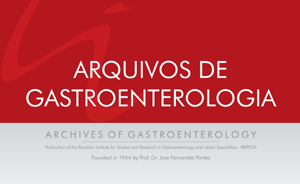|
|
Inflammatory Bowel Disease
-
Adérson Omar Mourão Cintra Damião, Faculty of Medicine, University of São Paulo (FMUSP), São Paulo, SP, Brazil. Orcid: 0000-0001-7584-7351, Lattes: http://lattes.cnpq.br/199396458726767.
-
Flavio Steinwurz, Albert Einstein Hospital, São Paulo, SP, Brazil. Orcid: 0000-0003-1002-9766, Lattes: http://lattes.cnpq.br/4609077637003387.
-
Genoile Oliveira Santana, Federal University of Bahia (UFBA), Salvador, BA, Brazil. Orcid: 0000-0001-5936-9791, Lattes: http://lattes.cnpq.br/4773453840819191.
-
Rogerio Saad-Hossne, São Paulo State University Júlio de Mesquita Filho (UNESP), Botucatu, SP, Brazil. Orcid: 0000-0002-8166-0304, Lattes: http://lattes.cnpq.br/9526345156590477.
-
Wilson Roberto Catapani, Faculty of Medicine of ABC (FMABC), Santo André, SP, Brazil. Orcid: 0000-0002-0412-2182, Lattes: http://lattes.cnpq.br/3761254264695648.
Surgery
-
Bruno Zilberstein, Faculty of Medicine, University of São Paulo (FMUSP), São Paulo, SP, Brazil. Orcid: 0000-0002-1809-8558, Lattes: http://lattes.cnpq.br/5798956841015747.
-
Carlos Walter Sobrado, Faculty of Medicine, University of São Paulo (FMUSP), São Paulo, SP, Brazil. Orcid: 0000-0003-4486-9894, Lattes: http://lattes.cnpq.br/7392452934213730.
-
Denis Pajecki, Faculty of Medicine, University of São Paulo (FMUSP), São Paulo, SP, Brazil. Orcid: https://orcid.org/0000-0002-0898-9285, Lattes: http://lattes.cnpq.br/6461797427653450.
-
Fabio Guilherme Campos, Faculty of Medicine, University of São Paulo (FMUSP), São Paulo, SP, Brazil. Orcid: 0000-0002-6233-6904, Lattes: http://lattes.cnpq.br/1173236565065518.
-
Jaques Waisberg, Faculty of Medicine of ABC (FMABC), Santo André, SP, Brazil. Orcid: 0000-0003-2775-8068, Lattes: http://lattes.cnpq.br/8316985163665041
-
José Eduardo Monteiro da Cunha, Faculty of Medicine, University of São Paulo (FMUSP), São Paulo, SP, Brazil. Orcid: 0000-0002-9847-302X, Lattes: http://lattes.cnpq.br/2198938358145976.
-
Marcelo Averbach, Sírio Libanês Hospital, São Paulo, SP, Brazil. Orcid: 0000-0002-3491-5781, Lattes: http://lattes.cnpq.br/3076448387104630.
-
Marco Aurélio Santo, Faculty of Medicine, University of São Paulo (FMUSP), São Paulo, SP, Brazil. Orcid: https://orcid.org/0000-0002-7813-6210, Lattes: http://lattes.cnpq.br/5427221669223755.
-
Nelson Adami Andreollo, University of Campinas (UNICAMP), Campinas, SP, Brazil. Orcid: 0000-0001-7452-1165, Lattes: https://lattes.cnpq.br/6300296790217820.
-
Odery Ramos, Faculty of Medicine, Federal University of Paraná (UFPR), Curitiba, PR, Brazil. Orcid: 0000-0002-9730-6860, Lattes: http://lattes.cnpq.br/6677752692090866.
-
Osvaldo Malafaia, Faculty of Medicine, Federal University of Paraná – (UFPR), Curitiba, PR, Brazil. Orcid: 0000-0002-1829-7071, Lattes: http://lattes.cnpq.br/0300957415364593.
-
Paulo Gustavo Kotze, Cajuru University Hospital, Pontifical Catholic University of Paraná (PUC-PR), Curitiba, PR, Brazil. Orcid: https://orcid.org/0000-0002-9632-6691, Lattes: http://lattes.cnpq.br/3666549932136698.
-
Paulo Herman, Faculty of Medicine, University of São Paulo (FMUSP), São Paulo, SP, Brazil. Orcid: https://orcid.org/0000-0003-2859-5846, Lattes: http://lattes.cnpq.br/7428163118766273.
-
Sthela Maria Murad Regadas, Federal University of Ceará (UFC), Fortaleza, CE, Brazil. Orcid: https://orcid.org/0000-0002-9905-6981, Lattes: http://lattes.cnpq.br/8022426727672340.
-
Ulysses Ribeiro Júnior, Faculty of Medicine, University of São Paulo (FMUSP), São Paulo, SP, Brazil. Orcid: 0000-0003-1711-7347, Lattes: http://lattes.cnpq.br/9157688546548677.
Endoscopy
-
Adriana Safatle Ribeiro, Faculty of Medicine, University of São Paulo (FMUSP), São Paulo, SP, Brazil. Orcid: 0000-0001-7686-8859, Lattes: http://lattes.cnpq.br/6955068649809708.
-
Eduardo Guimarães Hourneaux de Moura, Faculty of Medicine, University of São Paulo (FMUSP), São Paulo, SP, Brazil. Orcid: 0000-0002-8023-3722, Lattes: http://lattes.cnpq.br/9694526461831091.
-
Fauze Maluf Filho, Faculty of Medicine, University of São Paulo (FMUSP), São Paulo, SP, Brazil. Orcid: 0000-0001-8875-420X, Lattes: http://lattes.cnpq.br/7139764228632176.
Pathology
-
Aloisio Souza Felipe da Silva, University of São Paulo, São Paulo, SP, Brazil. Orcid: 0000-0001-6668-7907, Lattes: http://lattes.cnpq.br/5903072692070497.
-
Venâncio Avancini Ferreira Alves, Faculty of Medicine, University of São Paulo (FMUSP), São Paulo, SP, Brazil. Orcid: 0000-0001-5285-4460, Lattes : http://lattes.cnpq.br/8923271345704795.
Hepatology
-
Ana Cláudia de Oliveira, Faculty of Medicine, Federal University of São Carlos (UFSCar), Piracicaba, SP, Brazil. Orcid: 0000-0002-1148-7235, Lattes: http://lattes.cnpq.br/2363540409201023.
-
Angelo Alves de Mattos, Federal University of Health Sciences of Porto Alegre - UFCSPA, Porto Alegre, RS, Brazil. Orcid: https://orcid.org/ 0000-0003-2417-976, Lattes: http://lattes.cnpq.br/6055108568623425.
-
Claudia P. Marques Souza de Oliveira, Faculty of Medicine, University of São Paulo (FMUSP), São Paulo, SP, Brazil. Orcid: https://orcid.org/0000-0002-2848-417X, Lattes: http://lattes.cnpq.br/8930335778301812.
-
Edna Strauss, Hospital do Coração, São Paulo, SP, Brazil. Orcid: 0000-0002-7882-8671, Lattes: http://lattes.cnpq.br/1000980298010349.
-
Mário Guimarães Pessôa, Faculty of Medicine, University of São Paulo (FMUSP), São Paulo, SP, Brazil. Orcid: https://orcid.org/0000-0002-0942-7348, Lattes: http://lattes.cnpq.br/3454068838778698.
-
Paulo Lisboa Bittencourt, Hospital Português, Salvador, BA, Brazil. Orcid: https://orcid.org/0000-0003-0883-4870, Lattes: http://lattes.cnpq.br/6824795442620131.
-
Wellington Andraus, Faculty of Medicine, University of São Paulo (FMUSP), São Paulo, SP, Brazil. Orcid: https://orcid.org/0000-0002-5162-138X, Lattes: http://lattes.cnpq.br/6870859879978339.
Dysphagia
-
Ana Maria Furkim, Federal University of Santa Catarina (UFSC), Florianópolis, SC, Brazil. Orcid: https://orcid.org/0000-0002-0781-5312, Lattes: http://lattes.cnpq.br/4751091882065732.
-
Roberta Gonçalves da Silva, São Paulo State University Júlio de Mesquita Filho (UNESP), Botucatu, SP, Brazil. Orcid: https://orcid.org/0000-0002-2016-3566, Lattes:http://lattes.cnpq.br/5222023511286058
Nutrition
Gastroenterology
-
Decio Chinzon, Faculty of Medicine, University of São Paulo (FMUSP), São Paulo, SP, Brazil. Orcid: 0000-0003-3030-6687, Lattes: http://lattes.cnpq.br/7002394741259344.
-
Joaquim Prado P. de Moraes Filho, Faculty of Medicine, University of São Paulo (FMUSP), São Paulo, SP, Brazil. Orcid: 0000-0003-1280-6047, Lattes: http://lattes.cnpq.br/4960462847279758.
-
Luiz Gonzaga Vaz Coelho, Federal University of Minas Gerais (UFMG), Belo Horizonte, MG, Brazil. Orcid: 0000-0002-8721-7696, Lattes: http://lattes.cnpq.br/5789031316045886.
-
Maria do Carmo Friche Passos, Faculty of Medicine, Federal University of Minas Gerais (UFMG), Belo Horizonte, MG, Brazil. Orcid: 0000-0002-5247-9477, Lattes: http://lattes.cnpq.br/4553737124468779.
-
Nora Manoukian Forones, Faculty of Medicine, Federal University of São Paulo (UNIFESP), São Paulo, SP, Brazil. Orcid: 0000-0001-9414-0343, Lattes: http://lattes.cnpq.br/7314943504526739.
-
Ricardo Correa Barbuti, Faculty of Medicine, University of São Paulo (FMUSP), São Paulo, SP, Brazil. Orcid: 0000-0002-1910-119X, Lattes: http://lattes.cnpq.br/8634191033764162.
-
Rosa Leonôra Salerno Soares, Fluminense Faculty of Medicine, Federal Fluminense University (UFF), Niterói, RJ, Brazil. Orcid: https://orcid.org/0000-0002-2858-1922, Lattes: http://lattes.cnpq.br/4236328959320774
Experimental Surgery
Digestive Motility
-
Gerson Ricardo de Souza Domingues, Faculty of Medicine, Federal University of Rio de Janeiro (UFRJ), Rio de Janeiro, RJ, Brazil. Orcid: 0000-0003-0431-451X, Lattes: http://lattes.cnpq.br/0341919725026667.
-
Lucia Camara de Castro Oliveira, Consulting, Teaching and Medical Research Ltd. (CEPEMED), Rio de Janeiro, RJ, Brazil. Orcid: 0000-0002-1911-568X, Lattes: http://lattes.cnpq.br/8490847658206751.
-
Roberto Oliveira Dantas, Faculty of Medicine, University of São Paulo (FMUSP), Ribeirão Preto, SP, Brazil. Orcid: 0000-0003-2183-0815, Lattes: http://lattes.cnpq.br/3674926390608865.
-
Tomás Navarro Rodriguez, Faculty of Medicine, University of São Paulo (FMUSP), São Paulo, SP, Brazil. Orcid: 0000-0002-3458-699X, Lattes:http://lattes.cnpq.br/7428953154346559.
Pediatric Gastroenterology
-
Maria Angela Bellomo Brandão, State University of Campinas (UNICAMP), Faculty of Medical Sciences (FCM), Campinas, SP, Brazil. Orcid: 0000-0002-1145-2606, Lattes: http://lattes.cnpq.br/9933635060994680.
-
Mauro Batista de Morais, Faculty of Medicine, Federal University of São Paulo (UNIFESP), São Paulo, SP, Brazil. Orcid: 0000-0003-4014-5549, Lattes: http://lattes.cnpq.br/5056114729141952.
-
Mauro Sérgio Toporovski, Santa Casa, São Paulo, SP, Brazil. Orcid: 0000-0003-1525-7581, Lattes: http://lattes.cnpq.br/2238219109670914.
|
|
